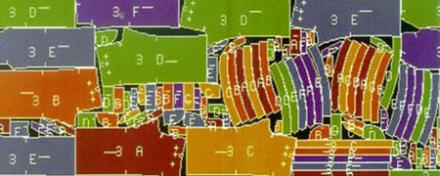 Marker making is the economical consumption of the material. Because material savings are a fundamental factor for every apparel firm, we have spent time to developing solutions that apply state of the art technology for material optimization. We offers a fast and efficient marker making service with both plain and matched fabrics. Our marker making provides an additional opportunity for better control of the different phases of the process while maintaining maximum efficiency. We can use the previously graded pattern or the customer will provide a digitized copy of the style.
Marker making is the economical consumption of the material. Because material savings are a fundamental factor for every apparel firm, we have spent time to developing solutions that apply state of the art technology for material optimization. We offers a fast and efficient marker making service with both plain and matched fabrics. Our marker making provides an additional opportunity for better control of the different phases of the process while maintaining maximum efficiency. We can use the previously graded pattern or the customer will provide a digitized copy of the style.
Once your pattern has been entered into our system, we can produce highly efficient markers according to your Marker Order Specification. We place the pattern pieces on a marker with all the notes, details, and indicating the grain line. We ensure that each piece is positioned for optimized fabric usage, maximizing productivity and minimizing labor and material loss.
Our marker maker takes the graded patterns and traces them onto paper, making a layout plan or roadmap to the cut of the style. The goal is to use the least amount of fabric possible, while keeping grain lines and match stripes aligned properly. Our marker makers carefully plan the placement of pieces and keep in mind the needs of the cutting department.
Using the approved graded patterns we will make highly efficient based on your order, which will reduce fabric costs, increasing your profit margins. We will consider yours requirements regarding the shrinkage, the kinds of fabric-plaid or stripe, block buffer, block fuse.
We provide you the high economy of materials by arrangement of patterns in marker with extremely small percentage of waste materials.
We will comply with your requirements for fusing elements of block paving, the way of paving and putting up, shrinkage of the material, as well as the requirements for meeting details in the fabric of plaid or striped.
The finished markers can be drawn in real size on a plotter or on a printer as mini markers. They can be written in HPGL plotter format and sent over the Internet to be drawn with a plotter to another location, or to be written in CUT file for all automatic machines for cutting
There are several benefits to having your markers produced using our service:
- Improved efficiency will reduce fabric costs;
- Electronic markers may be sent via email to avoid costly shipping charges and reduce delivery time;
- If recruits are necessary, the markers are readily available for reprinting;
We can save your markers in our database if cut a new or changes are necessary.
What is Marker Making?
Marking refers to the process of placing pattern pieces to maximize the number of patterns that can be cut out of a given piece of fabric in order to make garments.Pattern making is a highly skilled technique which calls for technical ability, sensitivity for design interpretation and a practical understanding of the process technology used by the factory.
Once the pattern is graded, the fabric must be prepared for cutting. In order to spread the fabric properly, the spreader must know how the pattern pieces will be placed on the fabric. “Marking” refers to the process of placing pattern pieces to maximize the number of patterns that can be cut out of a given piece of fabric. Firms strive for “tight” markers largely because fabric is one of a manufacturer’s most significant business costs, often exceeding the cost of labor. Although markers can be made by hand or using CAD software, the computerized method is up to eight times faster. Once a marker is completed, a CAD system can use a plotter to print a full size layout on a long sheet of paper. This layout becomes the guide for the cutter.
Computer software helps the technicians create the optimum fabric layout to suggest so fabric can be used efficiently. Markers, made in accordance to the patterns are attached to the fabric with the help of adhesive stripping or staples. Markers are laid in such a way so that minimum possible fabric gets wasted during cutting operation. After marking the garment manufacturer will get the idea of how much fabric he has to order in advance for the construction of garments. Therefore careful execution is important in this step.
Computer marking is done on speciallized softwares. In computerized marking there is no need of large paper sheets for calculating the yardage, in fact, mathematical calculations are made instead to know how much fabric is required.
Not every marking is on every pattern because some are specific to a certain style or construction technique. Layout and cutting markings don’t need to be transferred to the fabric. Construction markings, on the other hand, are very helpful during the sewing process and transferring them to the fabric is a good idea.
